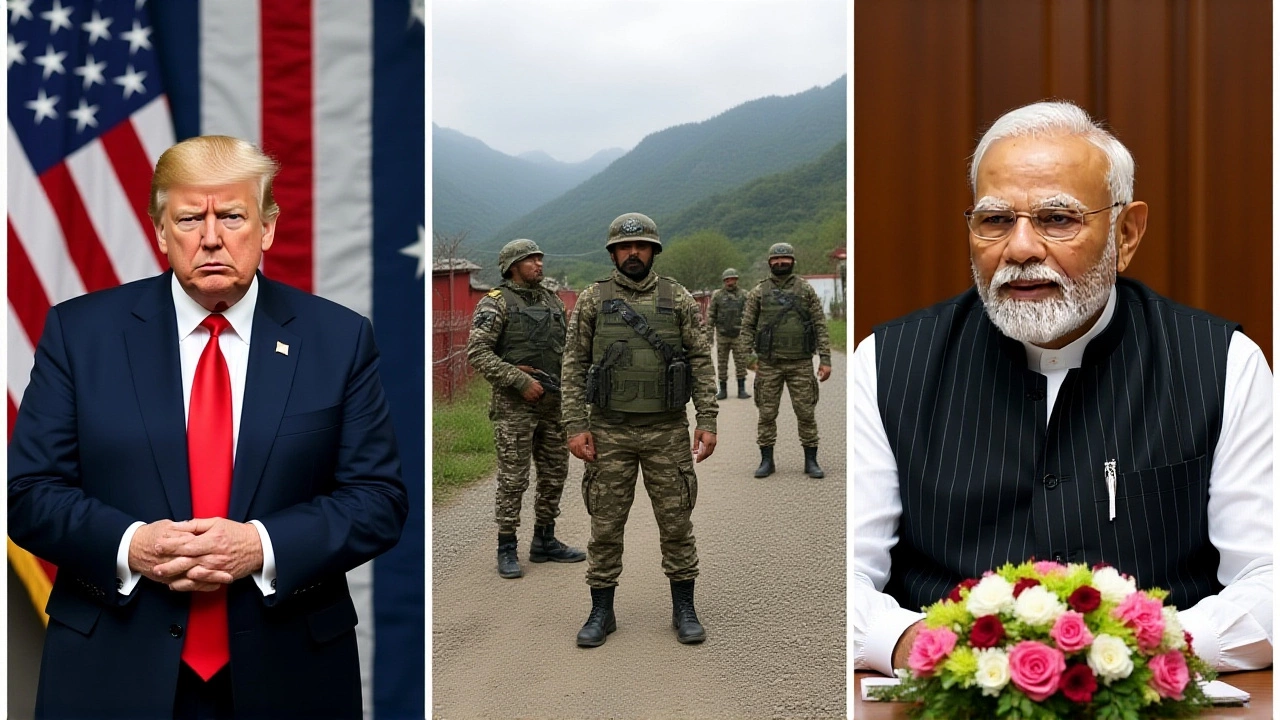When Pahalgam Terror Attack unfolded on April 22, 2025, in the green‑sprawling Baisaran Valley near Pahalgam, Jammu and Kashmir, 26 tourists were slain and more than 20 wounded. The gunmen, dressed in military‑style uniforms and armed with M4 carbines and AK‑47s, asked each victim about their faith before opening fire, sparing women and children but deliberately killing Hindus and a Nepali Christian. The brutal calculus shocked the nation and set off a chain of diplomatic and military maneuvers that now threatens to drag the sub‑continent into a wider crisis.
Background: A Region Long Haunted by Insurgency
Jammu and Kashmir has been a flashpoint since the late 1980s, when an Islamist insurgency erupted against Indian rule. Over the decades, the exodus of Kashmiri Hindus in the early 1990s left a communal scar that still influences politics. Terrorist outfits such as Lashkar‑e‑Taiba (LeT) have repeatedly used the mountainous terrain to stage attacks, from the 2000 Kishtwar massacre to the 2019 Pulwama suicide bombing that killed 40 paramilitary personnel. Analysts at Chatham House note that the 2025 assault came “at a time when the Pakistani military is on the back foot following a string of terrorist attacks inside Pakistan,” underscoring a possible shift in tactics from cross‑border strikes to provocation within India’s own borders.
What Happened on the Day of the Attack
Between 1:00 p.m. and 2:30 p.m. local time, a small convoy of tourists – families from Delhi, a school trip from Ahmedabad, and a lone Nepali pilgrim – arrived at the meadow via horseback and footpaths that wind through dense pine forests. Suddenly, three to six militants emerged from the treeline, shouting orders in Urdu and pointing their rifles at the group. According to eyewitnesses, a local pony operator named Syed Adil Hussain Shah lunged at the nearest gunman, wrested the weapon, and was immediately shot dead. His heroic act was captured on a zip‑line camera carried by a tourist and later broadcast on national news.
After the initial volley, the assailants methodically approached each individual, demanding a declaration of religion. When a young man from Gujarat identified as Hindu, a bullet ripped through his chest; when the Nepali Christian woman answered “Christian,” a shot followed. Women and children were ordered to stay back, a disturbing “humane” gesture that nonetheless turned the massacre into a targeted hate crime.
Local police, who were stationed at the nearest check post in Pahalgam, arrived thirty minutes later and found the meadow littered with bodies, some still clutching their travel bags. The attackers vanished into the forest, leaving behind shell casings and a single discarded helmet equipped with a small camera – evidence that would later be used to trace the group’s communication links.
Claims, Retractions, and the Geopolitical Ripple
Within hours, a statement appeared on the website of The Resistance Front, a Pakistan‑based outfit that the United Nations lists as an offshoot of Lashkar‑e‑Taiba. The claim read: “We carried out the Baisaran operation to punish those who ignore our religion.” Four days later, the same channel retracted the claim, reportedly after pressure from Pakistan’s security establishment, a reversal confirmed by a UN Security Council report dated July 29, 2025.
In New Delhi, the Cabinet Committee on Security (CCS) – chaired by Prime Minister Narendra Modi – met on April 23, 2025, to map a response. Foreign Secretary Vikram Misri addressed the nation on May 7, 2025, saying India would remain “focused, measured and non‑escalatory,” while stressing that “our response is aimed at the perpetrators, not the Pakistani people.”
India’s retaliation, code‑named Operation SINDOOR, involved a multi‑pronged set of actions: suspension of the 1960 Indus Waters Treaty, closure of the Integrated Check Post at Attari with a May 1 deadline for all travellers to exit, expulsion of about 1,200 Pakistani nationals, and a temporary shutdown of Indian airspace over the northern sector. Artillery exchanges across the Line of Control (LoC) were limited to a handful of shells, as both sides sought to avoid a full‑scale war.
India’s Response: Operation SINDOOR
Operationally, the Indian Army mobilised two infantry battalions to the LoC, while the Air Force placed fighter squadrons on standby. The Ministry of Home Affairs reported the seizure of 12 illegal firearms and three communication devices that matched the make of the helmets recovered at the attack site. Moreover, the Indian Navy deployed a missile‑capable vessel to the Arabian Sea as a deterrent, a move praised by defense analyst R. K. Sinha as “a calibrated signal that India can project power beyond its borders without crossing the red line of full‑blown war.”
On the diplomatic front, New Delhi lodged a formal protest at the United Nations, demanding that Pakistan hand over the masterminds behind the assault. Pakistan, in turn, denied any state involvement and claimed that the attacks on the Shambhu Temple in Jammu, the Gurdwara in Poonch, and several Christian convents were “isolated incidents by fringe elements.” Both sides exchanged a barrage of accusations on social media, fueling communal tensions in several Indian states.
Expert Analysis and Future Outlook
The Peace Research Institute Frankfurt (PRIF) published a paper on May 12, 2025, arguing that the attack marks “a shift from cross‑border terrorism to internal provocation aimed at fracturing India’s pluralist fabric.” The authors warned that continued targeting of religious minorities could embolden extremist factions within India, potentially leading to a spiral of retaliatory violence.
Conversely, the Pacific Forum’s commentary No. 35, released on April 25, 2025, suggested that India’s measured response is likely to deter further high‑profile attacks, referencing the 2019 Pulwama‑Balakot episode where a swift Indian airstrike forced Pakistan to recalibrate its own militant patronage.
What lies ahead remains uncertain. If diplomatic channels fail, the risk of a larger exchange of artillery or limited air strikes could rise, especially as both capitals watch each other’s moves closely. For the families of the slain tourists, the tragedy is a stark reminder that even remote hill stations are not immune to the geopolitics that roil the sub‑continent.
Key Facts
- Date: April 22, 2025 (1:00 – 2:30 p.m. IST)
- Location: Baisaran Valley, near Pahalgam, Anantnag district, Jammu and Kashmir
- Casualties: 26 dead (25 Indians – all Hindus except one Nepali Christian) and >20 injured
- Perpetrators: 3‑6 militants, linked to The Resistance Front, an offshoot of Lashkar‑e‑Taiba
- Indian response: Operation SINDOOR – treaty suspension, border closure, expulsion of Pakistani nationals, limited artillery exchange
Frequently Asked Questions
Why were non‑Muslim tourists specifically targeted?
The militants asked each person to declare their religion before shooting. The attackers said they wanted to punish those they considered “anti‑Islamic,” a tactic meant to sow communal fear and provoke a reaction from India’s Hindu majority.
What is the significance of India suspending the Indus Waters Treaty?
The treaty, signed in 1960, governs water sharing of the Indus River system between India and Pakistan. By suspending it, New Delhi signals that political and security disputes can now spill over into vital resource agreements, raising concerns about future water scarcity in the arid regions of both countries.
Who was Syed Adil Hussain Shah and why is his story important?
Shah was a local pony‑operator who tried to wrest a gun from one of the attackers, sacrificing his life. His bravery became a symbol of civilian resistance and was highlighted in official statements as an example of “ordinary Indians standing up to terror.”
How does this attack compare to the 2019 Pulwama bombing?
Pulwama targeted paramilitary forces and triggered a full‑scale airstrike on Balakot. The Baisaran assault, by contrast, hit civilians in a tourist spot, aiming to ignite communal fault lines. Both incidents led to swift Indian retaliation, but the latter has milder military escalation so far.
What are experts predicting for the next few months?
Security analysts say the risk of a larger artillery clash is high if diplomatic talks stall. However, the measured tone of both foreign secretaries suggests both sides may still prefer a limited conflict to avoid regional destabilisation.

